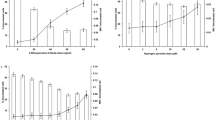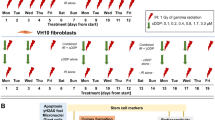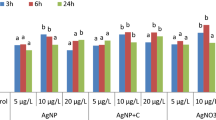Abstract
The inhibition of cell growth, the reduction of cell survival and the induction of chromosome aberrations and of sister chromatid exchange (SCE) have been determined in cultured hamster cell lines (BHK and CHO) treated with 11 water-soluble compounds of hexavalent and trivalent chromium. All Cr6+ compounds inhibit growth of BHK cells and reduce survival of CHO cells to levels comparable to those obtained only after exposure to 100--1000 times higher Cr3+ concentrations. The cytotoxicity curves obtained with the different Cr6+ compounds are almost overlapping, whereas marked differences of activity are noticeable among Cr3+ compounds. Giant cells are obtained after exposure to Cr6+ and Cr3+ compounds, as shown by the rise of DNA and RNA per cell, and are due to the blockage of the cell cycle without sudden inhibition of macromolecular syntheses. Both Cr6+ and Cr3+ compounds are able to induce chromosome aberrations, whereas Cr3+ is absolutely incapable of inducing SCE, only Cr6+ being active. The frequency of chromosome aberrations is increased about 10-fold after exposure to 1.0 micrograms/ml Cr6+, whereas it is only doubled after treatment with up to 150 micrograms/ml Cr3+. On the other hand, in spite of the sensitivity of CHO cells to the induction of SCE by mitomycin C, the frequency of SCE hardly doubles after exposure to Cr6+ compounds. The present data confirm that Cr6+ compounds are characterized by a marked cytotoxicity and clastogenic action on mammalian cell cultures and show that Cr3+ compounds, though cytotoxic only at extremely high concentrations and not increasing the frequency of SCE, are not completely without cytogenetic effect, as they are able to induce chromosome aberrations.
This is a preview of subscription content, access via your institution
Access options
Subscribe to this journal
Receive 24 print issues and online access
$259.00 per year
only $10.79 per issue
Buy this article
- Purchase on Springer Link
- Instant access to full article PDF
Prices may be subject to local taxes which are calculated during checkout
Similar content being viewed by others
Rights and permissions
About this article
Cite this article
Levis, A., Majone, F. Cytotoxic and clastogenic effects of soluble chromium compounds on mammalian cell cultures. Br J Cancer 40, 523–533 (1979). https://doi.org/10.1038/bjc.1979.217
Issue Date:
DOI: https://doi.org/10.1038/bjc.1979.217
This article is cited by
-
Cholesterol-lowering drug, in combination with chromium chloride, induces early apoptotic signals in intracellular L. donovani amastigotes, leading to death
Journal of Biosciences (2017)
-
Enhancement of myelotoxicity induced by repeated irradiation in mice exposed to a mixture of groundwater contaminants
Archives of Toxicology (1993)
-
In vitro cytotoxicity of metals to bluegill (BF-2) cells
Archives of Environmental Contamination and Toxicology (1986)
-
Chromium resistant mutants of the yeast Saccharomyces cerevisiae
Current Genetics (1982)



